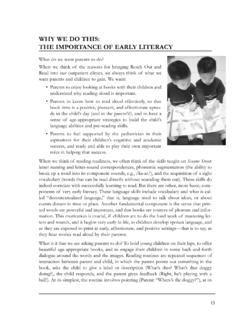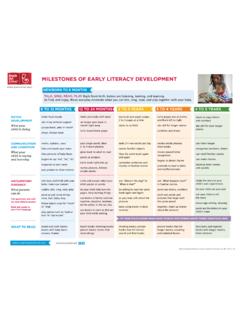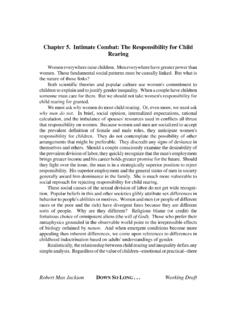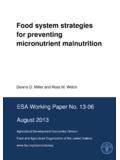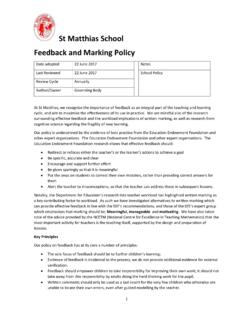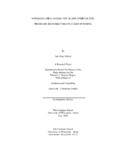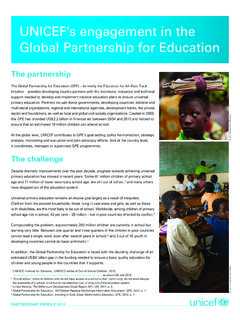Transcription of Reading aloud to children: the evidence - Reach …
1 Reading aloud to children : theevidenceE Duursma,1M Augustyn,2B Zuckerman2 Promoting healthy child development liesat the heart of paediatric practice, yet amajor challenge facing the field is applyingevidence based standards. However, theevidence is clear as regards Reading aloud tochildren. Ample research demonstrates thatreading aloud to young children promotesthe development of language and otheremergent literacy skills,1 4which in turnhelp children prepare for aloud AND children SEMERGENT LITERACY AND LANGUAGESKILLSR eading aloud to children or shared book- Reading has been linked to young chil-dren s emergent literacy ability, whichcan be defined as the skills or knowledgethat children develop before learning themore conventional skills of Reading andwriting6 8which affect children s latersuccess in shared bookreading, childrenlearn to recognise letters, understand thatprint represents the spoken word, andlearn how to hold a book.
2 Turn the pageand start at the 12 Sharedbookreading is also associated with learn-ing print concepts11and exposing childrento the written language register, which isdifferent from spoken language,13as wellas story structures (eg, stories have abeginning, middle and end) and literacyconventions such as syntax and grammarwhich are essential for emergent literacy skills areimportant for later success in AWARENESS ANDALPHABET KNOWLEDGEP honological awareness (the ability tomanipulate the sounds of spoken lan-guage1 16 18) is another important prere-quisite for learning to read. To readwords, children need to know the rulesfor translating print into example, preschoolers sen-sitivity to alliteration and rhyme at age 4 5 contributed to progress in Reading andspelling at age 6 s knowl-edge of nursery rhymes at age 3 4 isrelated to detecting alliteration and rhymeat ages 4 parents naturallypromote awareness of sound patterns byemphasising rhyming words and patternswhen Reading to a childrendo well at detecting and manipulatingsyllables, rhymes and phonemes, theytend to learn more quickly to 19 22 children acquire sensitivity to differentsounds in a specific order.
3 Although stagestend to can learn aboutphonemes or sounds more or less infor-mally by learning to name letters and byrecognising which phoneme is critical inthe alphabet books, forexample, contain the letter name accom-panied by pictures of objects whose namesbegin with the critical sound, such as D,for example a dog, deer or doctor. Whenparents stress the initial sounds in thesewords while Reading with their children ,they are teaching awareness of initialphonemes or shared phonemes 25 Since children who have diffi-culty with phonological awareness candevelop Reading difficulties,126parentsmight help to prevent these difficultiesby exposing children to a wide variety ofliteracymaterialsandhelpingthembecome aware of the relationship betweenletters and addition to being aware of sounds, children also need to recognise the rolethat alphabet letters play and that lettershave different sounds.
4 It is easier to learnthese letter sound relationships once chil-dren know at least some alphabet lettersand are able to recognise words that startwith the same sharedbookreading promotes children s alphabetknowledge,10most parents focus on themeaning of the story and not the , while knowing the names of lettersis not itself related to Reading ability, it isknowing the sound of letters (eg, the letter b sounds like ba ) that is are important differences in letterknowledge between children from middleclass and lower class families. Four-year-oldchildren from middle class families knewan average of 54% of the letter names and5-year-old children knew 85% of , 4- and 5-year-old chil-dren from low-income families who enterprograms such as Head Start know onaverage four letters and learn an additionalfive while enrolled in the 30 Alphabet and counting books for youngchildren promote greater focus on aloud AND LANGUAGEDEVELOPMENTS tudies demonstrate a relationship be-tween oral language skills such as vocabu-lary, syntactic (the way in which ling-uistic elements such as words are combinedto form sentences) and semantic (focus onthe meaning of words or sentences)
5 Pro-cesses, and narrative discourse processessuch as memory, storytelling and compre-hension,9and Reading of thesecontribute to word recognition and 33 children s oral language skills can bestimulated by parent child literacy learn the meaning of new wordsduring bookreading interactions withtheir aloud familiariseschildren with the language found 38 Books contain many words,especially the more sophisticated wordsthat children are unlikely to s books contain 50% more rarewords than prime-time television or evencollege students can stimulate more verbalinteraction between child and parent, andtherefore children s language developmentis likely to profit more from Reading aloudthan from toy play or other adult 41In addition to new voca-bulary, children are exposed to the morecomplex language adults use interactingwith children around a 42 43 Childrenwithgreatervocabularyknowledge and understanding of spokenlanguage tend to have less trouble social class differenceshave been reported in children s exposureto oral language and their and Risley reported that at age 3, children in professional families heard anaverage of 2153 words per hour.
6 Whilechildren in working class families heard1251 words per hour and children inwelfare families heard only 616 wordsper led to enormous differ-ences in children s vocabularies. At age 3,1 Reach Out and Read National Center, Boston, MA,USA;2 Department of Pediatrics, Boston UniversitySchool of Medicine, Boston, MA, USAC orrespondence to:Barry Zuckerman, Department ofPediatrics, Boston University School of Medicine, OneBoston Medical Center Place, Dowling 3 South, Boston,MA 02118, USA; article554 Arch Dis ChildJuly 2008 Vol 93 No 7 on 23 June 2008 from children in professional families had anobserved cumulative vocabulary of 1100words, while children in working classfamilies had an observed vocabulary of750 words and those in welfare families ofjust above 500 words.
7 In professionalfamilies, parents not only talked morebut also used more different words andprovided a greater richness of nouns,modifiers and verbs. Parents spent a lotof time and effort asking their childrenquestions, affirming and expanding theirresponses and encouraging their childrento listen and notice how words relate andrefer in order to prepare their children fora culture focusing on symbols andanalytic problem solving (see Hart andRisley,44p 133). On the other hand,parents on welfare spent less time talkingwhile they more frequently initiatedtopics and used more imperatives andprohibitions. These parents were moreconcerned with established customs suchas obedience, politeness and families showed a mixtureof the two cultures using imperatives andprohibitives while using rich language tolabel, relate and discuss bookreading provides childrenwith opportunities to learn vocabularyfrom books as well as the use of decon-texualised language (the use of languageto communicate new information tothose who have little experience withthe context of the information).
8 45 46 Sincethis task involves cognitive and linguisticdemands, it tends to be more challengingfor positive effects ofhaving been read to from an early agecontinue to be observable in the elemen-tary school age at whichparents begin Reading to their children iscorrelated with children s language devel-opment; children who are read to from anearly age tend to have higher scores onlanguage measures later 48 Reading aloud AS A SHAREDEXPERIENCEAn added dimension of Reading aloud isthat it involves parents and other impor-tant adults to the child in a focusedinteraction. Early parent child relation-ships influence children s engagement inliteracy activities. Mothers with securelyattached children tend to more frequentlyprovide a rich and interactive way ofreading to their children than mothers 49 51 children not only acquire knowledgeabout narratives but also learn about theirown personal narrative when sharing abook with an adult, something that can play an important rolein wake and sleep patterns by makingbookreading part of bedtime books with children can also helpthem learn about peer relationships, cop-ing strategies, building self-esteem andgeneral world aloud likely promotes jointattention, which has many potentialbenefits related to Reading ,52such asenhancing receptive language by askingchildren to point.
9 Touch or show duringbookreading or expressive language byasking children questions about the INFLUENCING QUANTITY ANDSTYLE OF SHARED BOOKREADINGS imilar to child health problems, certain risk factors such as socioeconomicstatus, race/ethnicity and parental educa-tion can affect children s development ofemergent literacy and oral language National Center for EducationStatistics (NCES), for example, foundthat children in families with incomesbelow the poverty threshold are less likelyto show signs of emergent literacy skillssuch as pretending to read and of 28% of children aged 3 5 yearswho were not living in poverty were ableto recognise all the letters of the alphabet,while only 10% of children living inpoverty were able to do so.
10 In addition,45% of children not living in povertyshowed three or more signs of emergingliteracy, while only 19% of children livingin poverty did with these lower levels ofemergent literacy skills is less exposure tobookreading and print. children from low-income families often participate less fre-quently in shared bookreading than chil-dren from higher socioeconomic 55 According to the Federal Interagency Forumon Child and Family Statistics, 64% offamilies whose incomes were at or abovethe poverty level read to their preschoolerson a daily basis compared to 48% of familiesbelow the poverty in low-income families oftenhave less access to printed materials in thehome,54which likely impairs children searly language and literacy developmentand later Reading 2007 Nation s Report Card on Reading showedthat children from low-income familieshad lower Reading scores in grade 4 andgrade 8 than their peers from middle children are poor readersat the end of first grade the probabilitythat they will remain poor readers by theend of fourth grade has been reported tobe as high as sCommittee on the Prevention of ReadingDifficulties in Young children stated thatmost Reading difficulties can be preventedby ensuring that all children , in particularthose at risk for Reading difficulties.


